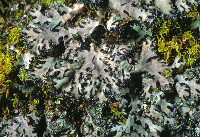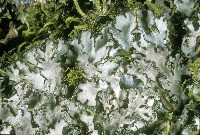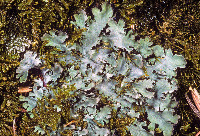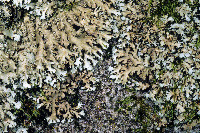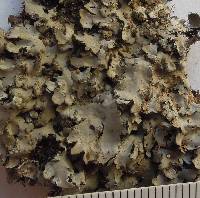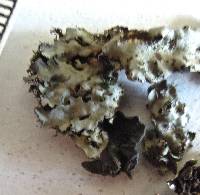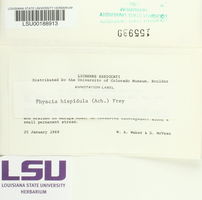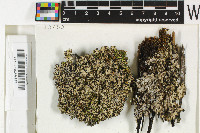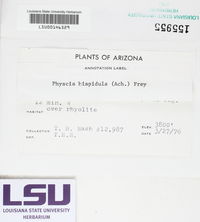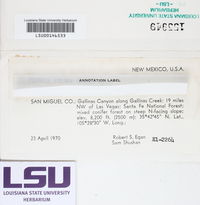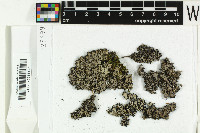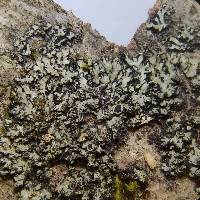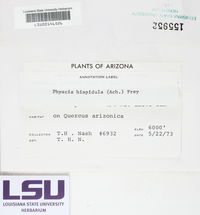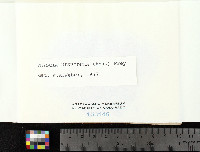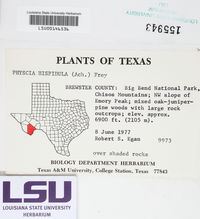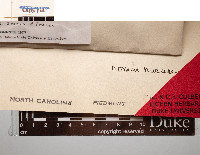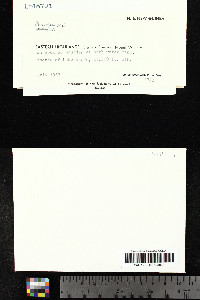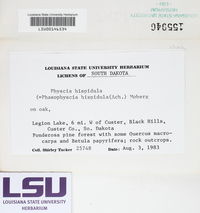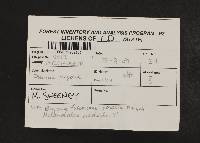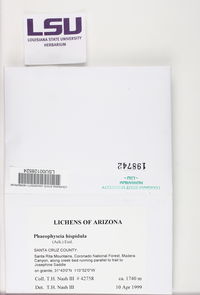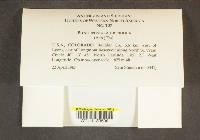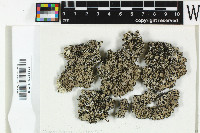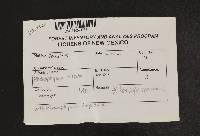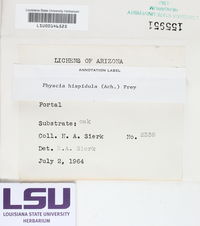
- Home
- Search
- Images
- Species Checklists
- US States: O-Z >
- US National Parks
- Central America
- South America
- US National Parks
- Southern Subpolar Region
|
|
|
|
Family: Physciaceae
Whiskered Shadow Lichen
[Dimelaena setosa (Ach.) Trevis., moreParmelia hispidula Ach., Parmelia setosa Ach., Phaeophyscia hispidula subsp. hispidula (Ach.) Essl., Phaeophyscia hispidula var. hispidula (Ach.) Essl., Physcia hispidula (Ach.) Frey, Physcia hispidula subsp. exornatula (Zahlbr.) Poelt, Physcia hispidula subsp. hispidula (Ach.) Frey, Physcia hispidula subsp. primaria Poelt, Physcia setosa (f. virella) B. de Lesd., Physcia setosa f. deminuta Cromb., Physcia setosa f. setosa (Ach.) Nyl., Physcia setosa f. sulphurascens Zahlbr., Physcia setosa f. virella B. de Lesd., Physcia setosa var. albociliata B. de Lesd., Physcia setosa var. exornatula Zahlbr., Physcia setosa var. setosa (Ach.) Nyl.] |
Assessed as Least Concern (LC), ver 3.1; August 25, 2017
DOWNLOAD full IUCN Assessment as PDF Common name(s): English: n/a Identification Information: Lobes brownish grey to greyish brown, 1-4 mm wide, somewhat concave with ascending apices and margins. Medulla white. Under side black, rhizines black, here and there white tipped, projecting beyond lobe margins and apices. Soralia laminal, protuberant, pustulate, becoming more or lesscapitate, the soredia farinaceous to granular. Apothecia uncommon. Spores 22-28 x 8-13flrn. Chemistry: No lichen substances. ASSESSMENT JUSTIFICATION [criteria: LC] This species is commercially harvested by Nepali communities and has being sold. Therefore, overexploitation could decline the species in its wild habitat. Because of the large global distribution area of this species, overexploitation in Nepal has a minimal effect on the global population (LC). Assessor/s: Devkota, S. & Weerakoon, G.; Reviewer/s: Scheidegger, C. Bibliography: Awasthi, D.D. (2007) A compendium of the macrolichens from India, Nepal and Sri Lanka. Bishen Singh Mahendra Pal Singh, India, Kolkata. Baniya, C.B. et al. (2010) The elevation gradient of lichen species richness in Nepal. The Lichenologist 42: 83-96. Devkota, S., Chaudhary, R. P., Werth, S. & Scheidegger, C. (2017a) Indigenous knowledge and use of lichens by the lichenophilic communities of the Nepal Himalaya. Ethnobiology and Ethnomedicine 13(15): 1-10. Devkota, S., Chaudhary, R. P., Werth, S. & Scheidegger, C. (2017b) Trade and legislation: consequences for the conservation of lichens in the Nepal Himalaya. Biodiversity Conservation 26: 2491–2505. IUCN (2017) The IUCN Red List of Threatened Species. Version 2017-3. Available at: www.iucnredlist.org. (Accessed: 7 December 2017). Sharma, L.R. (1979) Contributions to the lichen flora of Nepal. University of Lucknow , India. Singh, K.P. & Singha, G.P. (2010) Indian Lichens: An annotated checklist. Botanical Survey of India, Kolkata. Swinscow, T. D. V. & Krog, H. (1988) Macrolichens of East Africa. British Museum (Natural History), London.
Find out more about the IUCN Red List Categories and Criteria here. Nash, T.H., Ryan, B.D., Gries, C., Bungartz, F., (eds.) 2004. Lichen Flora of the Greater Sonoran Desert Region. Vol 2. Thallus: foliose, up to 11 cm in diam., sometimes coalescing into even larger thalli, irregular to +orbicular lobes: discrete or irregularly rounded and partly imbricate, (1-)24(-6) mm broad, distinctly concave and usually ascending somewhat at the end (rhizines of the lower surface nearly always visible and conspicuous from above, a few along each lobe usually mounted on the lobe margin and projecting almost straight upward) upper surface: gray to gray-brown or brown, usually dull, rarely weakly shiny, epruinose but rarely with a thin patchy epinecral layer, sorediate/isidiate soredia/isidia: granular to isidioid or occasionally irregularly lobulate, sometimes primarily laminal and remaining +granular, most commonly marginal or submarginal upper cortex: paraplectenchymatous medulla: white lower cortex: paraplectenchymatous lower surface: black, sometimes paler at the lobe ends, dull; rhizines: mostly simple, but often some older ones becoming sparsely squarrosely branched, black Apothecia: infrequent, up to 2 mm in diam., sessile; margin: entire or sometimes irregularly crenate, often bearing a dense corona of rhizines ascospores: ellipsoid, 18-25(-28) x 7-12(14) µm, Physcia-type Spot tests: all negative in cortex and medulla Secondary metabolites: none detected. Substrate and ecology: common on both bark and rock World distribution: North America, Europe and Africa Sonoran distribution: common in Arizona, Sonora, and Chihuahua; infrequent in Baja California and Baja California Sur. Notes: Structures for asexual reproduction in Phaeophyscia hispidula are very variable, from more or less orbicular, laminal soralia with granular soredia to primarily marginal/ submarginal clusters of strongly isidioid propagules, some of which occasionally even become lobulate. Intergradation between these various types is complete. The typical large and wide-lobed specimens are easily identified, but in parts of the study area, there are frequent, primarily epiphytic specimens, which are often smaller and with narrower lobed, overlapping in size with the many smaller species of Phaeophyscia. Still, they can be rather easily distinguished by their distinctly concave lobes and the numerous long rhizines (a few, at least, weakly squarrose), some of which project upward along the lobe margins. |
|
|
|












